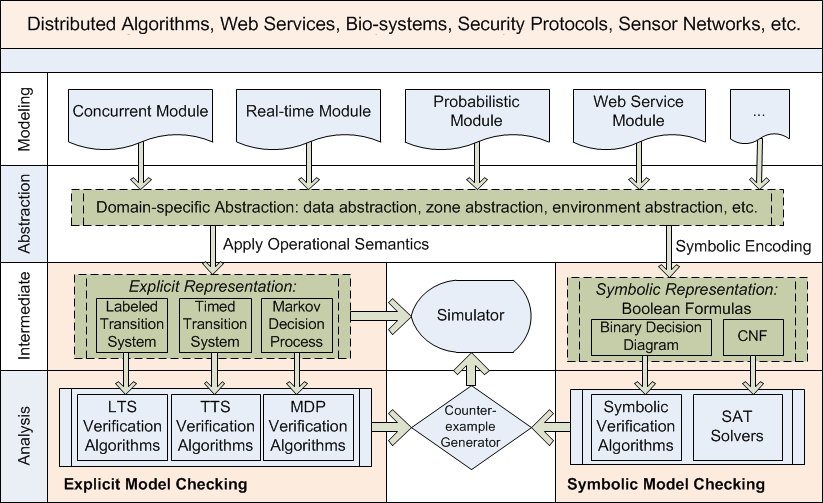 Process
Analysis Toolkit (PAT) 3.5
Help Process
Analysis Toolkit (PAT) 3.5
Help |
In our PAT framework, we adopt a layered design with an intermediate
representation layer (IRL), which separates modeling languages from model
checking algorithms. Hence these algorithms (or other analysis techniques like
testing) can be shared by different languages. As shown in the figure below,
PAT's architecture has four layers, which split the model
checking process into three steps: compilation,abstraction and verification.
This separation reduces the coupling between different functionalities, hence
increases the reusability of lower layers and the extensibility of upper layers.
The four layers are introduced in the following: Modeling Layer Abstraction
Layer Intermediate Representation Layer (IRL)
Analysis Layer (IRL)
Modeling layer
contains modules of the supported application domains (e.g., distributed system,
service oriented computing, security protocols and so on). It
identifies the domain specific language syntax, well-formness rules as well
as formal operational semantics, which are all encapsulated in a separate
module. Two key components which are the language parser and model
components (including syntax classes, variables, channels, etc.) consists this
layer.
Since model checking
techniques only work with finite state systems, while a system often has
infinitely many states according to its concrete operational semantics, that
(automated) state abstraction is essential. In this layer, we applied
abstraction technique into systems. For instance, zone abstraction abstract
infinite TTSs into finite ones, process counter abstraction to group identical
processes using process counter variables and ignore process identifiers (if
they are irreverent) which reduces state space significantly. Partial order
reduction to reduce all possible interleave execution orders of parallel running
processes into a particular execution order is another effective method.
After compilation and abstraction, the input model
is converted to some form of internal representations, which is the basis of the
model checking algorithms. Intermediate representation layer contains different
semantic representations for different model checking approaches.
This layer
contains reusable model checking algorithms. For each intermediate
representation in IRL, a set of algorithms are developed. For example, deadlock
checking, reachability checking, LTL verification with or without fairness
assumptions, refinement checking have been developed for LTS. If the
verification result is false, a counterexample is produced, which can be
visualized via simulator. 
Copyright © 2007-2012 Semantic Engineering Pte. Ltd.